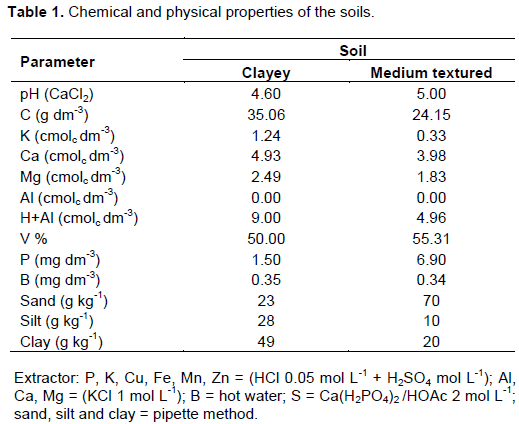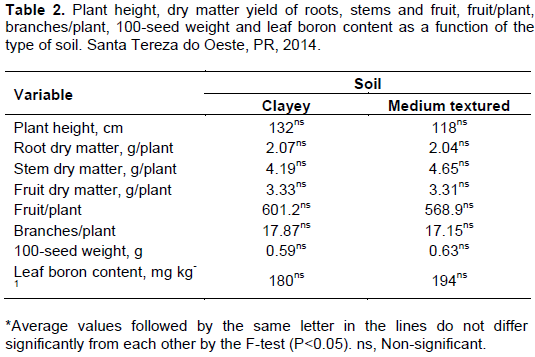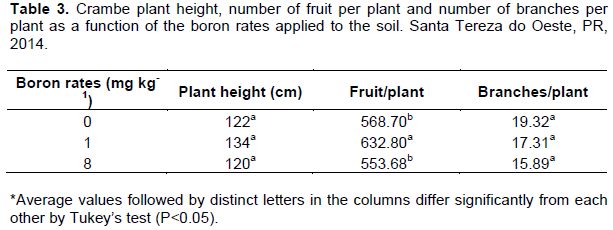The consolidation of crambe crops in the agricultural and industrial scenarios comes up against the lack of recommendations and technical information on their cultivation. Thus, this study aims to analyze the effects of boron fertilization on a crambe crop cultivated in two oxisols. The experiment was conducted in a greenhouse owned by the Agronomic Institute of Paraná, in the city of Santa Tereza do Oeste - PR. The treatments were arranged in a 2×3 factorial scheme. Two oxisols with different textures (clayey and medium texture) were used, and three boron rates (0, 1, and 8 mg kg-1) were applied to the soil. A randomized complete block design with five replications was used. The experimental unit consisted of a vase containing 2.0 kg of soil with two crambe plants. Plant height, dry matter yield of roots, stems and fruit, number of fruit per plant, number of branches per plant, 100-seed weight and leaf boron content were assessed. Soil texture did not affect any variable. There was no significant interaction between the boron rates applied and soil texture. Plant heights, number of branches per plant and fruit dry matter were not influenced by the boron fertilizer. The number of fruit per plant as well as the dry matter yield of roots, stems and fruit was higher with the application of 1 mg B kg-1 of soil. The amount of boron in the leaves was proportional to the fertilizer rates applied. The application of 8 mg B kg-1 of soil caused toxicity symptoms on crambe leaves.
Crambe is a winter crop that has stood out in the agricultural scenario due to the application possibilities of its oil, which is inedible and consequently best suited for biofuel production. Crambe oil also stands out for replacing oil fluids. According to Santos et al. (2012), crambe oil may be employed in various industries in the production of industrial lubricants, rubber, nylon, plastics, adhesives and others.
Pitol et al. (2010) highlight some advantages of the crambe crop, as its low cost for implementation and maintenance, tolerance to drought and low temperatures, short growing season (approximately 90 days) and seed oil content of roughly 40%. Santos et al. (2012) also point out that crambe shows easy adaptation, rusticity and precocity. It also allows mechanization at all stages of cultivation, using adapted technologies that have already been employed in the production of other crops. In light of its advantages, Pitol et al. (2010) highlight the crambe crop as an option for the off-season in the Midwest, South and Southeast of Brazil. However, crambe is an exotic and unfamiliar crop in Brazil and research on its development is still required in order to bring to light technical information and support to future large-scale production in the agro-energy scenario. Knowing the amount of nutrients required by a crop is highly important for its development, however, recommendations concerning to the fertilization of crambe crops are still scarce (Rosolem and Steiner, 2014).
Crambe has an elevated boron extraction power and requires larger quantities of this element than other crops. Bergamin et al. (2005) explain that boron nutrition should be performed frequently for the cultivation of plants of the Brassica family, in view of the positive responses observed as a result of boron fertilization.
Boron acts directly on the transport of sugars, respiration, formation of the plasma membrane, nitrogen metabolism, RNA metabolism, ascorbate metabolism, indole acetic acid, hormone activity and reduced aluminum toxicity (Gondim et al., 2014; Zanão-Junior, 2012; Guerra, 2013). According to Dechen and Nachtigall (2007), boron also acts on pollen tube growth and consequently on flowering and grain yield.
Boron deficiency causes several changes in plant physiology. Symptoms vary according to plant species and age (Zanão-Junior, 2012). The main symptom of boron deficiency is reduced leaf surface, which causes younger leaves to become deformed, small and fragile. There is also accumulation of nitrogen compounds in old leaves and little root development, as well as low resistance to diseases (Dechen and Nachtigall, 2007; Guerra, 2013). According to Bastos and Carvalho (2004), evidence shows that short-term boron deficiency leads to decreased yield.
Studies on crambe phytotechnology, macronutrient fertilization and use of its oil in industrial processes are found in the literature, however, little is known about its responses to nutrition with micronutrients such as boron or about its development in different types of soil. Thus, the purpose of this study was to evaluate crambe response to boron fertilization in two oxisols.
The experiment was conducted from July to October, 2014, in a greenhouse owned by the Agronomic Institute of Paraná, in Santa Tereza do Oeste, State of Paraná.
The treatments were arranged in a 2×3 factorial scheme with two Oxisols of different textures (clayey and medium texture). Three boron rates (0, 1, and 8 mg kg-1) were applied. A randomized complete block design with five replications was used. The experimental unit consisted of a vase containing 2.0 kg of soil with two crambe plants. Samples of both soils were collected at a depth of 0-20 cm and characterized in terms of physical and chemical properties (Table 1).

Twenty crambe seeds (cv. FMS Brilhante) were sown per vase at a depth of 1 cm and 200 mg P dm-3 of soil were added. Calcium phosphate fertilizer (CaHPO4) was added as the source of phosphorus.
Thinning was carried out 11 days after emergence, leaving five plants per vase, when boric acid (17.7% B) was also applied.
The first application of nutrient solution composed of N, K, Ca, Mg, S, Zn, Cu and Mn took place at 15 days after emergence. The second thinning was performed at 30 days after emergence, leaving two plants per vase. Then, the second portion of the fertilizer was added. At all stages, fertilization was performed using nutrient solutions (100 ml vase-1 in each application). Soil moisture was measured using a small evaporation tank maintained at approximately 80% of its field capacity.
At the end of the cycle, the plant shoot was collected, washed with deionized water and dried in an oven with forced air at 65°C for 72 h. Then, the dry matter yield of stems, fruit and roots, 100-seed weight, average plant height and number of branches and fruit per plant were determined.
After being weighed, the leaves were ground in a Wiley mill with a 0.84 mm sieve and calcined at 550°C. Boron rates were determined by using the colorimetric method with azomethine-H reagent (Wolf, 1971).
Data obtained were processed in Assistat® software and subjected to analysis of variance (ANOVA). The interaction soil texture/boron rate was analyzed by Tukey’s test at 5% significance in order to assess the effects of boron rates on each soil.
There was no significant interaction between soil texture and boron rates for the variables, therefore, the average data were presented separately. The type of soil in which the experiment was conducted did not affect the responses obtained for the variables presented in Table 2.

The average plant height was 132 cm in the clayey soil and 118 cm in the medium textured soil (Table 2). These values were higher than those presented by Reginato et al. (2013), in which crambe plants reached on average 117 cm in an Oxisol, depending on the time and depth of seeding.
Root dry matter yield reached 2.07 g/plant in the clayey soil and 2.04 g/plant in the medium textured soil (Table 2). Janegitz et al. (2010) achieved an average root dry matter yield of 4.9 g crambe/plant in an experiment that evaluated the effect of base saturation on medium textured soils.
The average stem dry matter yield in the clayey soil was 4.19 and 4.65 g/plant in the medium textured soil (Table 2). Prates et al. (2014) reported a stem dry matter yield of 1.56 and 4.02 g crambe/plant with the application of silicate, with and without the application of sulfur, respectively.
Fruit dry matter averaged 3.33 g/plant in the clayey soil and 3.31 g/plant in the medium textured soil. The number of branches per crambe plant reached averages of 17.87 in the clayey soil and 17.15 in the medium textured soil (Table 2).
The average number of fruit per plant in the clayey soil was 601.2 and 568.9 in the medium textured soil (Table 2). Such results are superior to those found by Ferreira and Silva (2011) in the assessment of grain yield and oil content of a crambe crop under different management systems in a Red-Yellow Latosol. The authors found an average yield of 153.32 fruit per plant in the soil under reduced tillage, 160.84 fruit per plant in the soil under conventional tillage and 177.52 fruit per plant in the soil under no-tillage.
Both clayey and medium textured soils presented an average 100-fruit weight of 0.59 and 0.63 g, respectively (Table 2). These results are inferior to those obtained by Rogério et al. (2013) in the assessment of different phosphorous fertilizer rates applied to a crambe crop. These authors found an average 100-fruit weight of 2.3 g in a typical dystrophic Red Latosol. The lack of statistically significant effects according to the type of soil may be justified by the suitable pH and base saturation of both soils. Moreover, irrigation and the application of nutrients were performed homogenously in both soils, which provided similar conditions for plants to develop.
Table 3 shows the effects of the boron rates applied on plant height, number of fruit per plant and number of branches per plant. The rates applied presented no significant effect on plant height and number of branches per plant. However, the number of fruit per plant presented a significant response to the boron rates applied.

The average height of the crambe plants was 122, 134 and 120 cm for the application of 0, 1 and 8 mg kg-1 boron doses, respectively (Table 3). Bonacin et al. (2009) did not find significant effect on plant height when applying boron doses between 0 and 4 kg ha-1 in sunflower (Helianthus annuus) cultivated in a Red Latosol. Furlani et al. (2001) did not verify height difference in four soybean (Glycine max) cultivars (IAC-1, IAC-8, IAC-15 and IAC-17) as a result of boron fertilization. According to the authors, only one cultivar (IAC-8) had a significant response for this variable, likely due to a genetic enhancement. Guerra (2013) assessed four boron doses (0, 0.5, 1 and 2 kg ha-1) applied to a Red Latosol with sandy texture with two canola (Brassica napus) cultivars (Hyola 76 and Hyola 401) and also did not observe any significant effect on plant height as a function of the boron doses applied to the soil.
Grain yield was higher with the application of 1 mg kg-1 B to the soil, with an average of 632.8 fruits per crambe plant. Other averages presented were 568.70 and 553.68 fruits for applications of 0 and 8 mg kg-1 doses of boron to the soil, respectively. The averages did not differ from each other (Table 3).
The average number of branches per plant was 19.32, 17.31 and 15.89 for 0, 1 and 8 mg kg-1 B doses, respectively (Table 3). The lack of significant response for this variable as a function of the doses of boron applied to the soil was also observed by Guerra (2013) in a canola crop. One reason that might justify the lack of significant response of the number of branches to the application of boron is that the number of branches is a genetic characteristic little influenced by it.
The crambe root dry matter yield was higher with the application of 1 mg kg-1 B, reaching 2.62 g plant-1 (Table 4). Other dry matter yields were 1.80 and 1.75 g/plant with the application of 0 and 8 mg kg-1 B, respectively, not differing from each other. The content of boron naturally present in the soil (0 mg kg-1 B) was not enough to promote increment in the variable assessed. The dose of 8 mg kg-1 B had a toxic effect on the development of the root system (Table 4).

Souza et al. (2010) reported significant difference in the dry matter yield of the root system of arum-lily as a function of the boron doses added to the nutritive solution. Silva et al. (2008) also reported that ricinus plants cultivated without the presence of boron presented lower root dry matter yield than the ones with different boron doses. However, Silva et al. (2014) did not find significant difference in the dry matter yield in the assessment of papaya trees treated with 0, 1.43, 2.86, 4.29 and 5.72 mg L-1 B. In a work assessing boron doses of 1, 2 and 4 mg dm-3 in a sunflower crop, Marchetti et al. (2001) did not find any significant difference in the root dry matter yield as a function of the boron doses applied. Thus, this response seems to be related to the vegetal species and to the boron doses assessed.
As for the stem dry matter yield, there was a significant difference between the doses of boron applied. The highest yield, 4.61 g plant-1, was obtained with the application of 1 mg kg-1 B (Table 4). Fruit dry matter yield (3.68 g plant-1) was also higher with the application of 1 mg kg-1 B (Table 4). There was no significant difference in fruit dry matter yield: 3.12 and 3.15 g plant-1 with the application of 0 and 8 mg kg-1 B, respectively. Boron has a higher effect on the reproduction phase of the plant, as it acts directly in grain formation.
Guerra (2013), in the assessment of two canola cultivars, found the best response of fruit dry matter yield with the cultivar Hyola 76 treated with 5 kg ha-1 B. Pizetta et al. (2005) obtained a significant yield increase in brassica crops (Brassica oleracea var. italica, B. oleracea and B. oleracea var. capitata) as a function of boron fertilization in sandy soil. Echer and Creste (2011) reported yield increase as a function of the application of boron (0, 1 and 2 kg ha-1) in sweet potato in a sandy Red-Yellow clay soil. Yield increase as a result of boron fertilization is observed not only in brassicas. Although Pizetta et al. (2005) state that species of this family respond positively to boron application, the addition of this element to the soil, regardless of the type of soil or crop, promotes yield increase in species of other families too.
The thin line between ideal and toxic boron levels for plants is mentioned by Malavolta et al. (1997). In their work, 1 mg kg-1 B resulted in better dry matter yield of fruits, roots and stems as well as number of fruits. For the same variables, the 8 mg kg-1 dose of boron presented results that do not differ from those of the crop without boron application. The application of 8 mg kg-1 B possibly caused boron levels in the soil that are toxic to the plants.
There was no significant difference in the dry matter of a hundred grains as a function of the different doses applied, with averages of 0.58, 0.62 and 0.63 g for doses of 0, 1 and 8 mg kg-1 B, respectively (Table 4). Queiroga (2011) reported similar response in a sunflower crop. Guerra (2013) did not verify significant difference in the responses obtained for the dry matter of a hundred grains in two canola cultivars as a function of the application of boron.
Boron content in the leaves is shown in Table 4. Plants without the application of the nutrient presented leaf boron content of 54.50 mg kg-1. With the application of 1 mg kg-1 boron to the soil, leaf boron content was 132.46 mg kg-1. In the treatment with the application of 8 mg kg-1 B, crambe leaves presented visual symptoms of toxicity and the leaf boron content was 397.35 8 mg kg-1. Leaf boron content in crambe leaves is directly related to the boron doses applied to the soil. According to Marschner (1995), the critical boron toxicity limit varies according to the species, being 100 mg kg-1 for soybean and corn (Zea mays), 400 mg kg-1 for cucumber (Cucumis sativus) and 1000 mg kg-1 for pumpkin (Curcubita pepo). Zanão-Junior et al. (2014) found leaf boron content in rose (Rosa hybrida) ranging from 271 to 675 mg kg-1, the latter being considered toxic.
Visual symptoms of toxicity in crambe leaves due to excessive boron levels were observed in older leaves and only in plants that received doses of 8 mg kg-1 boron. They are similar to waterlogging symptoms and start in the boundary of the foliar limb. Posteriorly, there is the occurrence of chlorosis in the waterlogged areas that evolves to necrosis, what causes the leaves to fall. The main toxicity symptoms caused by the excess of boron observed are in accordance with those described by Zanão-Junior (2012).
The toxicity symptoms caused by the excess of boron occurred only in older leaves, what proves to be the low mobility of this element in plants. Thus, the location of these symptoms reflects boron distribution in most species, with its build up occurring in the parts of the plant where there is the last stage of the transpiration stream (Nable et al., 1997; Roessner et al., 2006).
Similar toxicity symptoms caused by excess boron were also found in experiments with B. oleracea, B. oleracea var. italica, B. oleracea var. capitate, B. napus, soybean and rose (Furlani et al., 2001; Pizetta et al., 2005; Guerra, 2013; Zanão-Junior et al., 2014) (Figure 1).
Plant height, number of branches per plant and 100-fruit dry matter was not influenced by boron fertilization. However, the number of fruit per plant and dry matter yield of roots, stems and fruit were higher with the application of 1 mg B kg-1 of soil. No variables were influenced by soil texture and the application of 8 mg B kg-1 of soil caused visual symptoms of toxicity in the crambe leaves.